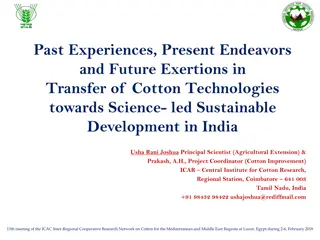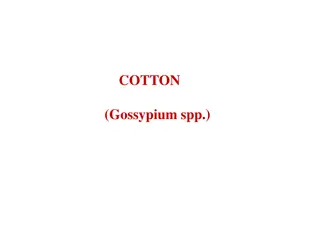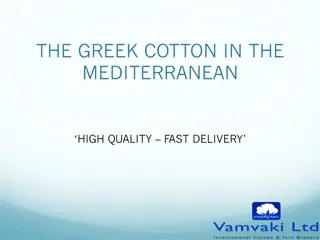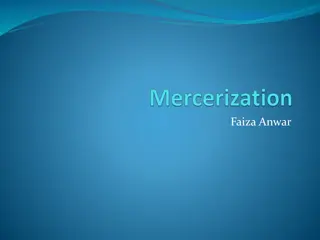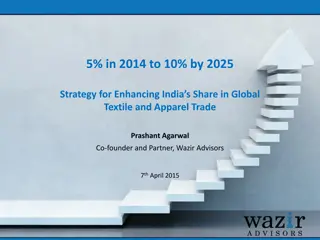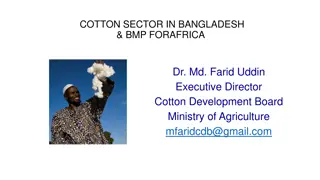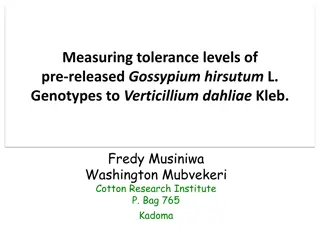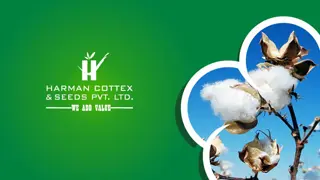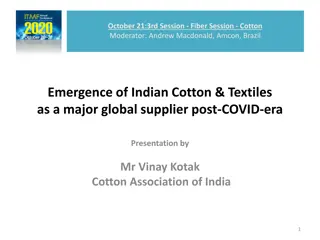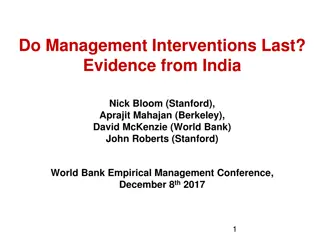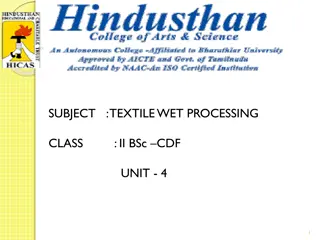Evolution of Cotton Textile Industry in India
Cotton textile industry in India has a rich history dating back to the 19th century, with major centers in regions like Maharashtra, Gujarat, and West Bengal. Production is dominated by powerlooms and handlooms, contributing significantly to both domestic consumption and export earnings.
Download Presentation

Please find below an Image/Link to download the presentation.
The content on the website is provided AS IS for your information and personal use only. It may not be sold, licensed, or shared on other websites without obtaining consent from the author. Download presentation by click this link. If you encounter any issues during the download, it is possible that the publisher has removed the file from their server.
E N D
Presentation Transcript
COTTON TEXTILE IN INDIA Cotton was the most important commodity traded in Ancient India to the Modern India. The origin of cotton textile industry dates back to 1818 AD when the first cotton textile mill was started at Fort Gloster near Calcutta but the first modern cotton textile mill was established in Bombay in 1854 by the local Parsi entrepreneur with the name of Bombay Spinning & Weaving Company.
The Cotton Textile centres in India are distributed in four regions: Western Region, Southern Region, Northern Region and Eastern Region. The states like Maharashtra, Gujarat, Tamil Nadu, Uttar Pradesh, Karnataka, Madhya Pradesh, Rajasthan and West Bengal have very high degree of concentration of this industry and especially in the three cities of Bombay, Ahmedabad and Coimbatore. Production: Cotton cloth is produced in three different sectors viz., 1. Mills, 2. Power-looms and 3. Handlooms.
1. Mills: The mill sector played a dominant role in cotton textile industry at the initial stage. But its importance was reduced drastically with the growth of powerlooms and handloom. The share of mill sector in cotton cloth production came down from 80.69 per cent in 1950-51 to only 5.37 per cent in 2003-04. 2. Powerlooms: The decentralised powerloom sector plays a pivotal role in meeting the clothing needs of the country. The production of cloth as well as generation of employment has been rapidly increasing in powerloom sector. contributes significantly to the cloth production in the country but also provides employment to millions of people. This sector not only
The powerloom industry produces a wide variety of cloth with intricate designs. The powerloom sector accounts for about 63 per cent of the total cloth production in the country and contributes significantly to the export earnings. 3. Handlooms: The handloom sector provides employment to over 65 lakh persons engaged in weaving and allied activities. The production of handloom fabrics registered more than fifteen fold increase from 500 million sq metres in 1950-51 to 7,585 million sq metres in 2001-02. This sector constitutes nearly 14 per cent of the total cloth produced in the country substantially to the export earnings. and also contributes
Although the total production of cotton cloth increased considerably, the share of mill sector has been drastically reduced. This is an indication of our efforts to decentralise the industry employment opportunities. There are about 40 lakh handlooms and about 5 lakh powerlooms in the decentralised sector. Although they are widely distributed throughout the country, states of Tamil Nadu, Uttar Pradesh, Assam and Manipur account for nearly 50 per cent of the production capacity. and create greater
Locational Factors: Several factors, like availability of raw cotton, market, transport, etc. play a key role in the localisation of cotton textile industry. The significance of raw cotton is evident from the fact that 80 per cent of the industry is coterminous with the cotton growing tracts of the country.
Geographical Distribution of Cotton Textile Industry in India 1. Maharashtra It is the leading producer of cotton textile in India. Mumbai is called as Cottonpolis of India . The textile industry has also spread to Sholapur, Kolhapur, Pune, Jalgaon, Akola, Sangali, Nagpur, Satara, Wardha, Aurangabad and Amravati. Following are the main reasons of phenomenal growth of cotton textile industry in and around Mumbai. (i) Mumbai enjoys humid climate which is helpful for this industry because thread does not break so frequently. (ii) Mumbai is a very important port which helps in import of machinery and long staple cotton and export of cloth. (iii) Cheap hydro-electricity is readily available from the nearby
(vi) There is ready market for Mumbai products both in India and abroad. (vii) Mumbai is well-connected by a network of roads and railways which help in easy transportation of raw material and finished goods. (viii) Facilities for washing and dyeing also exist here. (ix) There is no dearth of capital inputs. (x) Mumbai has the advantage of an early start.
2. Gujarat It is the second largest producer of cotton Maharashtra. called Manchester of India & Boston of East and it is also second largest centre of cotton textile industry after Mumbai. The other important centres are- Surat, Bharauch, Bhavnagar, Nadiad, Porbandar, Rajkot, mauri and Viramgam. textiles Ahmedabad after is Vadodara, Navsari,
Tamil Nadu Chennai, Virudhnagar centres. India because it is the most important cotton textile centre. 4. Uttar Pradesh Kanpur, Etawah, Modinagar, Moradabad, Bareilly, Hathras, Agra, Meerut and Varanasi are the major cotton textile producing centres in the state. Kanpur is called Manchester of Uttar Pradesh . 5. Karnataka Bangalore, Belgaum, Mangalore, Chitradurga, Galbarga and Mysore are the major cotton textile producing centres in the state. Tirunelveli, and Coimbatore Madurai, are called Tuticorin, major Manchester Salem, textile South Polachi is the cotton of
Madhya Pradesh Indore, Gwalior, Mandasaur, Dewas, Ujjain, Nagda, Bhopal, Jabalpur and Ratlam are the major cotton textile producing centres in the state. 7. Rajasthan Kota, Jaipur, Sriganganagar, Bhilwara, Bhavanimandi, Udaipur and Kishangunj are the major cotton textile producing centres in the state. 8. West Bengal The major cotton textile producing centres in the state are Kolkata, Howrah, Serampore, Shyamanagar, Saikia, Murshidabad, Hugli and Panihar.
Economy Contribution India is the world s largest cotton producer, accounting for ~38% of global cotton acreage and ~23% of global cotton production. It is also the second largest exporter (after the USA) and the second largest consumer (after China). Within the country, Maharashtra has the highest area under cultivation, at 41.2 lakh ha, followed by Gujarat at 27.1 lakh and Telangana at 17.9 lakh. Together, these three states account for 72% of the total cotton acreage in the country.
The decline in production has also resulted in a significant decline in the closing stock of the cotton market in India. It was 8.5 mn bales as on Mar 19, compared to 12.6 mn during the same period last year. Owing to the increase in cotton prices vis - - vis other crops like soybean and paddy, acreage is likely to shift towards cotton in 2019 - 20 ($A estimates 3.2% YoY rise in acreage). The cotton market in India is likely to recover from the subdued 2018 - 19 cotton season, during which yield declined by 11%. Production in 2019 - 20 is estimated to grow ~17%, as both
Recent Development According to the Ministry of Textiles Cotton Textiles Export Promotion Council (TEXPROCIL), there was a 26% growth in cotton textile exports between April - September 2018. TEXPROCIL has also proposed to include cotton yarn, a value - added product, under the Merchandise Exports from India Scheme (MEIS) to boost the cotton textile industry in India. Government of India has been rendering support to the cotton textile sector through initiatives such as Scheme for Integrated Textile Parks (SITP), Integrated Skill Development Scheme (ISDS), Integrated Processing Development Scheme (IPDS), Market Development Assistance (MDA) and Market Access Initiative (MAI). Another Technology Upgradation Fund Scheme (ATUFS) has been provided under the special package of INR 6,000 cr for the push to Amended


